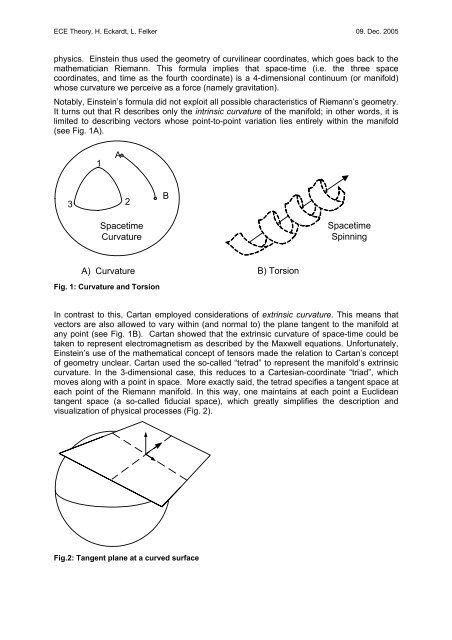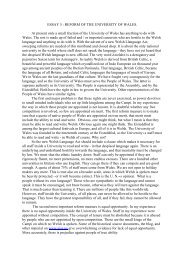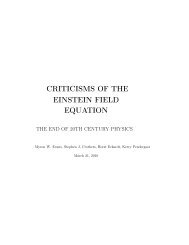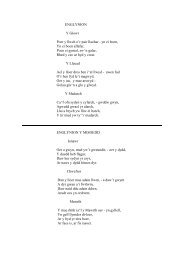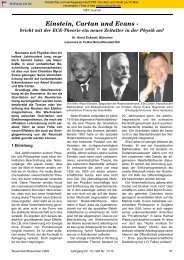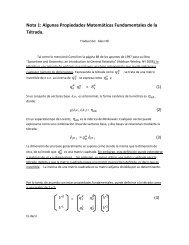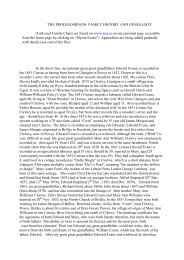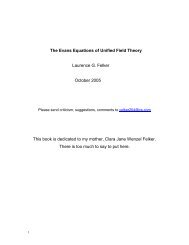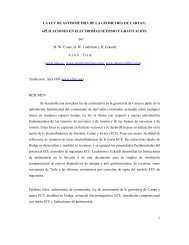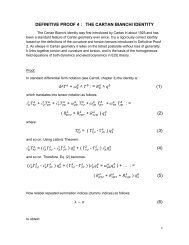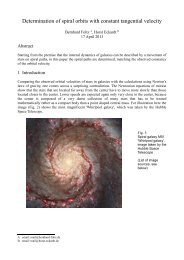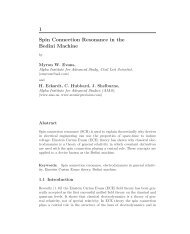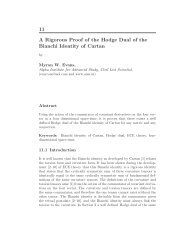Einstein, Cartan and Evans – Start of a New Age in Physics?
Einstein, Cartan and Evans – Start of a New Age in Physics?
Einstein, Cartan and Evans – Start of a New Age in Physics?
Create successful ePaper yourself
Turn your PDF publications into a flip-book with our unique Google optimized e-Paper software.
ECE Theory, H. Eckardt, L. Felker 09. Dec. 2005<br />
physics. <strong>E<strong>in</strong>ste<strong>in</strong></strong> thus used the geometry <strong>of</strong> curvil<strong>in</strong>ear coord<strong>in</strong>ates, which goes back to the<br />
mathematician Riemann. This formula implies that space-time (i.e. the three space<br />
coord<strong>in</strong>ates, <strong>and</strong> time as the fourth coord<strong>in</strong>ate) is a 4-dimensional cont<strong>in</strong>uum (or manifold)<br />
whose curvature we perceive as a force (namely gravitation).<br />
Notably, <strong>E<strong>in</strong>ste<strong>in</strong></strong>’s formula did not exploit all possible characteristics <strong>of</strong> Riemann’s geometry.<br />
It turns out that R describes only the <strong>in</strong>tr<strong>in</strong>sic curvature <strong>of</strong> the manifold; <strong>in</strong> other words, it is<br />
limited to describ<strong>in</strong>g vectors whose po<strong>in</strong>t-to-po<strong>in</strong>t variation lies entirely with<strong>in</strong> the manifold<br />
(see Fig. 1A).<br />
3<br />
1<br />
A<br />
2<br />
Spacetime<br />
Curvature<br />
A) Curvature<br />
Fig. 1: Curvature <strong>and</strong> Torsion<br />
B<br />
B) Torsion<br />
Spacetime<br />
Sp<strong>in</strong>n<strong>in</strong>g<br />
In contrast to this, <strong>Cartan</strong> employed considerations <strong>of</strong> extr<strong>in</strong>sic curvature. This means that<br />
vectors are also allowed to vary with<strong>in</strong> (<strong>and</strong> normal to) the plane tangent to the manifold at<br />
any po<strong>in</strong>t (see Fig. 1B). <strong>Cartan</strong> showed that the extr<strong>in</strong>sic curvature <strong>of</strong> space-time could be<br />
taken to represent electromagnetism as described by the Maxwell equations. Unfortunately,<br />
<strong>E<strong>in</strong>ste<strong>in</strong></strong>’s use <strong>of</strong> the mathematical concept <strong>of</strong> tensors made the relation to <strong>Cartan</strong>’s concept<br />
<strong>of</strong> geometry unclear. <strong>Cartan</strong> used the so-called “tetrad” to represent the manifold’s extr<strong>in</strong>sic<br />
curvature. In the 3-dimensional case, this reduces to a Cartesian-coord<strong>in</strong>ate “triad”, which<br />
moves along with a po<strong>in</strong>t <strong>in</strong> space. More exactly said, the tetrad specifies a tangent space at<br />
each po<strong>in</strong>t <strong>of</strong> the Riemann manifold. In this way, one ma<strong>in</strong>ta<strong>in</strong>s at each po<strong>in</strong>t a Euclidean<br />
tangent space (a so-called fiducial space), which greatly simplifies the description <strong>and</strong><br />
visualization <strong>of</strong> physical processes (Fig. 2).<br />
Fig.2: Tangent plane at a curved surface


